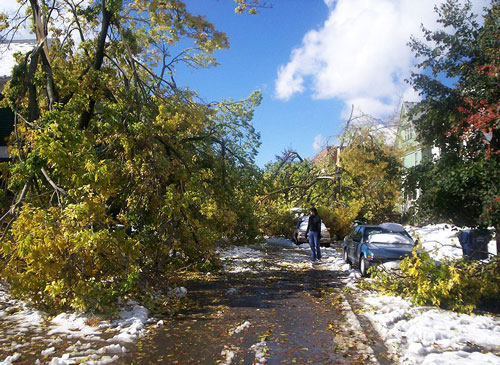Scientists examined changes in the growing season over the Northern Hemisphere during 1982 to 2008 and found that end of the growing season has shifted to later in the year. Scientists regard changes in the growing season as an important indicator of the response of terrestrial ecosystems to climate change. The results of the research were published in the July 2011 issue of the journal Global Change Biology and were further reviewed by Climate Central on October 17, 2012.
To measure the length of the growing season, scientists used NDVI (normalized difference vegetation index) data collected by satellites to estimate the “greenness” of vegetation growing across the Northern Hemisphere during 1982 to 2008. The NDVI calculates how much visible light is absorbed by vegetation. Healthy vegetation absorbs most visible light.
The scientists found that the length of the growing season has expanded over time due to both earlier starts to the growing season and later ends to the growing season.
Dates for the end of the growing season in the Northern Hemisphere ranged from September 17th to November 26th. While there were high amounts of variation in the data, the trends showed that the end of the growing season has shifted to later in the year. During 1982 to 1999, the end of the growing season was delayed by 4.3 days. During 2000 to 2008, the end of the growing season was further delayed by an additional 2.3 days. Overall, these data indicate that we are experiencing a long-term trend towards later autumn weather across the Northern Hemisphere.
The scientists believe that changes observed in the growing season were largely driven by changes in temperature and precipitation over the last several decades.
A longer growing season could have important implications for the carbon cycle, scientists say. According to Climate Central, leaves that stay green for longer may be able to absorb more atmospheric CO2 from the atmosphere, which could affect the annual timing of when CO2 builds up in the atmosphere. Atmospheric CO2 levels drop then rise again each year due to the growth (photosynthesis uses CO2) and decay (respiration releases CO2) cycles of vegetation in northern latitudes. The authors of the paper published in Global Change Biology note that while the annual net carbon exchange may not change by much, the amplitude of annual changes in atmospheric CO2 could be affected. They recommend that scientists further evaluate the impact that long-term changes in the growing season could have on the carbon cycle.
The research published in Global Change Biology was carried out by scientists from Seoul National University and the NASA Goddard Space Flight Center. It was funded by the Korea Meteorological Administration Research and Development Program.
I spent some time wondering what other implications a longer growing season could have on the Northern Hemisphere, and my thoughts turned to the tree damage caused by an unusual early-season lake effect snow storm that hit Buffalo, NY in October 2006. During that storm, also known as the “October Surprise,” extensive tree damage was caused by heavy snow falling on trees that had not yet lost their leaves. Could a longer growing season make these events more likely in the future?

Bottom line: Scientists examined changes in the growing season over the Northern Hemisphere during 1982 to 2008 and found that end of the growing season has shifted to later in the year. Scientists regard changes in the growing season as an important indicator of the response of terrestrial ecosystems to climate change. The results of the research were published in the July 2011 issue of the journal Global Change Biology and were further reviewed by Climate Central on October 17, 2012.











